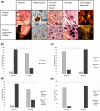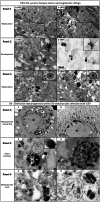Varicella-zoster virus in actively spreading segmental vitiligo skin: Pathological, immunochemical, and ultrastructural findings (a first and preliminary study)
- PMID: 36112095
- PMCID: PMC10092484
- DOI: 10.1111/pcmr.13064
Varicella-zoster virus in actively spreading segmental vitiligo skin: Pathological, immunochemical, and ultrastructural findings (a first and preliminary study)
Abstract
Segmental vitiligo (SV) is a unilateral subtype of vitiligo which is clinically characterized by a cutaneous depigmentation and histologically by a melanocyte loss from the epidermis and hair follicle reservoirs. To date, its pathogenesis remains a mystery. In many cases, this skin depigmentation shares several clinical features and dysfunctions with herpes zoster (HZ). So, for the first time, we examined whether any nucleus and cell fusion associated with a positive immunolabelling of varicella-zoster virus (VZV) and VZV mature virions could be found in SV skin samples as in herpes zoster (HZ). A total of 40 SV samples were used for histological and immunochemical studies. Control samples were obtained from three HZ, and 10 generalized vitiligo lesions. For ultrastructural study, three recent SV and one HZ as controls were recruited. Here, we report that nuclear fusion in epidermal cells were statistically associated with recent SV (p < .001), whereas syncytia formation was associated with long-lasting SV (p = .001). A positive detection of VZV antigen was statistically associated in the epidermis with recent SV and in the dermis with long-lasting SV (p = .001). Finally, the discovery of mature virions in 3/3 recent SV samples provides additional arguments for our viral hypothesis.
Keywords: autonomic nervous system; melanosome transport; nucleus fusion; segmental vitiligo; syncytium; ultrastructural study; varicella-zoster virus; viral cytopathic changes.
© 2022 The Authors. Pigment Cell & Melanoma Research published by John Wiley & Sons Ltd.
Conflict of interest statement
The authors declare that they have no conflict of interest.
Figures


Comment in
-
Revisiting the role of varicella zoster virus in segmental vitiligo.Pigment Cell Melanoma Res. 2023 Sep;36(5):439-440. doi: 10.1111/pcmr.13105. Epub 2023 Jun 15. Pigment Cell Melanoma Res. 2023. PMID: 37323109 No abstract available.
Similar articles
-
Segmental vitiligo distribution follows the underlying arterial blood supply territory: a hypothesis based on anatomo-clinical, pathological and physio-pathological studies.Front Med (Lausanne). 2024 Sep 18;11:1424887. doi: 10.3389/fmed.2024.1424887. eCollection 2024. Front Med (Lausanne). 2024. PMID: 39359912 Free PMC article.
-
Experimental approaches to assess melanocytes mosaicism in segmental vitiligo.An Bras Dermatol. 2023 Mar-Apr;98(2):216-220. doi: 10.1016/j.abd.2022.05.001. Epub 2022 Dec 16. An Bras Dermatol. 2023. PMID: 36529602 Free PMC article.
-
Varicella virus-mononuclear cell interaction.Adv Virus Res. 2003;62:1-17. doi: 10.1016/s0065-3527(03)62001-4. Adv Virus Res. 2003. PMID: 14719363 Review.
-
Segmental vitiligo: autoimmune pathogenesis, neuronal mechanisms, and somatic mosaicism.Int J Dermatol. 2025 Mar;64(3):490-498. doi: 10.1111/ijd.17627. Epub 2024 Dec 30. Int J Dermatol. 2025. PMID: 39739902 Review.
-
Age-Associated Differences in Infection of Human Skin in the SCID Mouse Model of Varicella-Zoster Virus Pathogenesis.J Virol. 2018 May 14;92(11):e00002-18. doi: 10.1128/JVI.00002-18. Print 2018 Jun 1. J Virol. 2018. PMID: 29563288 Free PMC article.
Cited by
-
Vitiligo.J Dtsch Dermatol Ges. 2025 Aug;23(8):968-987. doi: 10.1111/ddg.15706. J Dtsch Dermatol Ges. 2025. PMID: 40788636 Review.
-
Segmental vitiligo distribution follows the underlying arterial blood supply territory: a hypothesis based on anatomo-clinical, pathological and physio-pathological studies.Front Med (Lausanne). 2024 Sep 18;11:1424887. doi: 10.3389/fmed.2024.1424887. eCollection 2024. Front Med (Lausanne). 2024. PMID: 39359912 Free PMC article.
-
[Vitiligo-update on pathogenesis, diagnostics and therapy].Dermatologie (Heidelb). 2025 Mar;76(3):168-178. doi: 10.1007/s00105-024-05467-9. Epub 2025 Feb 4. Dermatologie (Heidelb). 2025. PMID: 39904778 Review. German.
-
Melanin: a unifying theory of disease as exemplified by Parkinson's, Alzheimer's, and Lewy body dementia.Front Immunol. 2023 Sep 29;14:1228530. doi: 10.3389/fimmu.2023.1228530. eCollection 2023. Front Immunol. 2023. PMID: 37841274 Free PMC article.
-
Vitiligo: are microbes to blame?Biosci Microbiota Food Health. 2025;44(1):16-25. doi: 10.12938/bmfh.2024-051. Epub 2024 Aug 30. Biosci Microbiota Food Health. 2025. PMID: 39764486 Free PMC article. Review.
References
-
- Arnozan, X. , & Lenoir, L. (1922). Vitiligo avec troubles nerveux sympathiques: l’ origine sympathique du vitiligo. Bulletin de la Société Française de Dermatologie et de Syphiligraphie, 12, 124–140.
-
- Attili, V. R. , & Attili, S. K. (2015). Anatomical segmentations in cell forms of vitiligo: A new dimension of etiopathogenesis. Indian Journal of Dermatology, Venereology and Leprology, 82(4), 379–388. - PubMed
-
- Barra, D. C. , & Seabra, M. C. (2004). The melanosomes as a model to study organelle motility in mammals. Pigment Cell Research, 17(2), 111–118. - PubMed
MeSH terms
LinkOut - more resources
Full Text Sources
Medical

